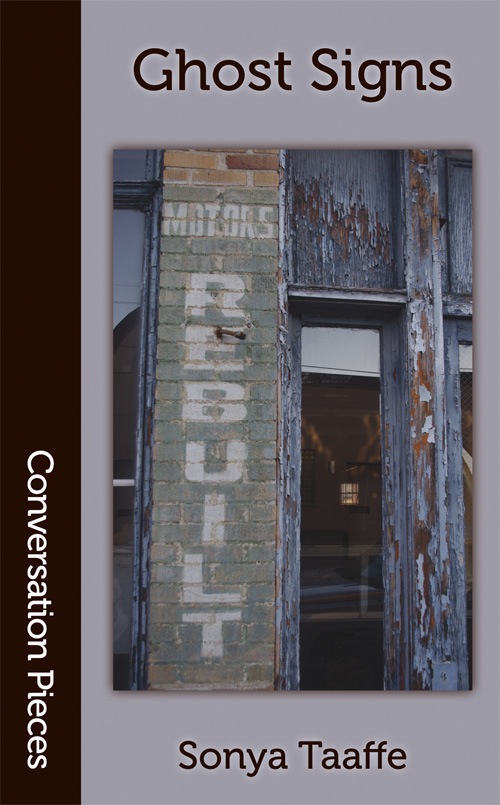Happy New Year, and welcome back to Rich and Strange, where I look with some depth at short fiction that has astonished and delighted me. This week I want to draw your attention to Sonya Taaffe’s novella “The Boatman’s Cure,” included as the concluding portion of her just-released poetry collection Ghost Signs, from Aqueduct Press.
Full Disclosure: I would be honoured to consider Sonya Taaffe a friend, but for the fact that she keeps my heart in a salt-encrusted bottle on her window-sill, and will insist on giving the bottle a shake whenever she knows I am reading her words.
In a collection—indeed, a congress—of ghosts, echoes, memories, and homages to ancient Greek literature, “The Boatman’s Cure” is a breath-taking culmination of its approaches and themes, a magnificent finale the intensity of which is derived from its quiet tension. Delia can see and interact physically with ghosts, and has discovered, through a great deal of trial and error, reliable ways of exorcising them; a personal quest requires her to obtain an oar with a strange history from an even stranger source. Nothing goes smoothly—except the beautiful structure of the story, which mimics the movement of an oar through water.
It makes a beautiful arc: the story opens with Delia and a dead man named Evelyn Burney—the oar’s custodian—in a car, on their way to an unspecified “home.” The oar dips, and we see how they met; it dips further, and we see how Delia came to her understanding of ghosts and how to send them on; the oar rises and we return to Delia’s conflict with the dead man, before rising further to complete the circle of them back in the car. The narrative oar then inscribes a second arc of a different character: one that moves through Delia’s own past, her very being, and does genuinely brilliant things with the folk themes of boatmen’s curses in folk tales, where the acceptance of an oar is the acceptance of a burden that will only pass by giving it to another person.
I can only with difficulty begin to describe Taaffe’s prose. Like her poetry, its dense layering makes me think of thick canopies of leaves with light passing through them; like her poetry, she favours a long sentence absolutely knotted with images, images to take into the mouth, to feel against one’s eyelids, to rub between one’s hands. A sentence that seems to only appeal to one’s vision nevertheless engages all the senses, as in this passage that I just want to gulp down with my gaze:
He had not been hard to find; at the time it had not surprised her. A printout with some notes scribbled over the phone had been all the directions she needed, following the signs from Ipswich until the roads wound into sea-lavender brushes and billows of salt hay, inlets glinting like sky-bright needles among the lowland green and beyond Plum Island, the Atlantic at her right hand, forever rolling home. Nothing for miles but cordgrass and curlews and the pale shells of cloud reflecting in the channels like sails, but no one else would have been living in this peeling, periwinkle-boarded stilt-walk of a house with oil-blue mussels clustered on the pilings and low tide already idling around the rust-sponged cement blocks—inside, Delia was half expecting the cabin of a China clipper or a beachcomber’s drift-line hoard, ship’s brasses and netted floats, tarry rope-ends and trade-wind charts, the smell of water everywhere and the windows screwed tight as museum crates with a long century’s newspapers to keep out the draft.
I can taste the oil-blue of the mussels, I want to sing the consonants in cordgrass and curlews. There’s also a depth of loving familiarity with Massachusetts that’s rendered into a wealth of mythic resonance: the ocean in this story isn’t wine-dark, and deliberately so, but it is strung with storied pearls.
I recommend, enormously, with the whole of my salt-bottled heart, the reading of Taaffe’s entire collection, which is very possibly her best yet; I only reserve judgment on that front because it’s been too long since I read Postcards from the Province of Hyphens. But if you aren’t a lover of poetry but are a lover of prose that’s rich and strange, I fervently recommend purchasing the collection for this story alone.
Amal El-Mohtar is totally not trying to trick you into buying a collection of poetry and is STILL totally not lying to you. She is the author of The Honey Month, a collection of stories and poems written to the taste of 28 different kinds of honey, and has now thrice received the Rhysling award for best short poem. Her short story “The Green Book” was nominated for a Nebula award. Her work has most recently appeared in Uncanny; in Lightspeed magazine’s special “Women Destroy Science Fiction” issue; and in Kaleidoscope: Diverse YA Science Fiction and Fantasy. She also edits Goblin Fruit, an online quarterly dedicated to fantastical poetry. Follow her on Twitter.










